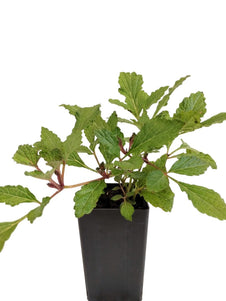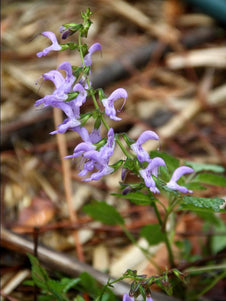







Salvia miltiorrhiza 'Red Rooted Sage'
Salvia miltiorrhiza 'Red Rooted Sage'

- In stock, ready to ship
- Inventory on the way

Usually available: All year
Life cycle: Herbaceous Perennial
Height: 30 - 60cm
Position: Sun / part shade
Soil preference: Well drained
This is how we pack and send your Herb Plants to all states except TAS & WA
You will receive
- 1 Salvia miltiorrhiza 'Red Rooted Sage' Herb Plant in a 50 X 75mm tube - General growing instructions
All of our Herb Plants are grown organically with certified organic potting mixes and fertilizers
Botanical Name: Salvia miltiorrhiza 'Red Rooted Sage'
Red Rooted Sage is a small shrub, growing from 30-60cm high with a similar spread. It is a deciduous perennial in cold regions and has branching stems with widely spaced leaves. The dark green foliage consists of simple, divided leaves with a pinnate structure and slightly crenate or mildly scalloped margins. The leaves sometimes have purple highlights. The whorls of flowers are blue-purple, covered in sticky hairs and have dark purple calyces. Floral spikes extend 30 cm above the foliage during spring and summer. The taps roots are red, as indicated by the name of the plant and about 2.5 cm in diameter. They are straight and fleshy, with no root bark.
Red Rooted Sage is known by the botanical name of Salvia miltiorrhiza, where the species name means ‘red ochre root’. It may also be called Chinese Sage, Dan Shen, or Tan Shen due to its links to Traditional Chinese Medicine. This salvia has a native range in China and Japan, where it prefers hillsides, forests and stream banks as habitat at elevations of 100-1200 meters. It is cultivated in China for its use in TCM.
The salvia family has over 900 members with an extensive history as culinary, medicinal and ornamental plants. Ornamental salvias have become collectors items, as gardeners try to find a place in their garden for each and every one. There are salvias that will suit every type of soil and climate. More information on the Salvia genus and Common Sage (Salvia officinalis) may be found on our Common Sage page.
Growing Conditions
Red Rooted Sage requires full sun for at least half the day and may be in afternoon shade. It prefers average water, with free draining soil that is moist but not wet. However, it will grow in clay, loam and any soil with average fertility. Although Red Rooted Sage is deciduous in its native environment and in cold winter climates, this may not be the case in warm temperate or sub-tropical regions. Generally, they are deciduous once temperatures lower than -3 Celcius is reached. Naturally this plant is cold hardy, but not usually very drought tolerant. Red Rooted Sage will sucker from root spread but this is easily controlled by digging up or dividing the plant.
Medicinal Uses
The red roots are used traditionally as part of the practice of Traditional Chinese Medicine and may be called Dan Shen. They are harvested after two years, in late autumn or early spring while the plant is dormant. The roots should be cleaned and dried, but be careful not to rub the roots too hard or the ‘red’ will be removed. In TCM, the roots are used for treating cerebrovascular disorders, cardiovascular problems and circulatory disorders, promoting blood circulation and as a general tonic. The outside of the root is used for treating chronic renal failure, diabetes, pancreatitis and may have anti-inflammatory and anti-oxidant qualities. It has anti-coagulant effects so should not be used by those on drugs such as Warfarin or drugs affecting circulation and blood thinning. It is also not recommended for those on drugs like Digoxin. Active constituents from Salvia miltiorrhiza or Red Rooted Sage are currently undergoing trials for registration with the United States Food and Drug Administration.
Culinary Uses
The leaves have a bitter flavour and may be used fresh or dried to flavour a variety of dishes, such as meats, sausages and poultry.
All information provided on this website is for informational purposes only. Please seek professional advice before commencing any treatment.






